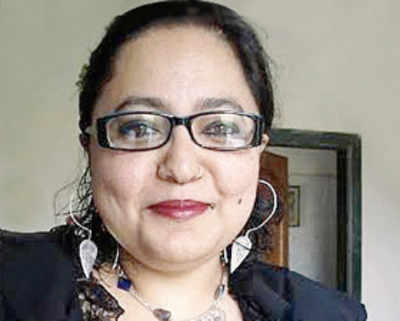Weapons of mass seduction

Paromita Vohra
The military, the government and corporations may invest in technology for war, surveillance and other types of world domination. People, however, always find a way to use it for love and desire.
In 1841, it first became possible to make multiple copies of a photograph. Almost immediately photography became the weapon to be used chiefly for erotica and romantic keepsakes. No sooner did telephones become available in homes, magazines everywhere, including India, started advertising them as instruments useful in an emergency accompanied by completely contradictory images of vampy allure. The phone romance, which possibly deserves its own column, is certainly an important Indian institution.
What is it about technology that fires our senses? Communications technology at least, is basically an extension of our senses. Society might be the headmaster of some part of our brains, deciding whom we ought to love and marry. It may dictate behavior based on shame or survival. Our senses are far more difficult to tame. Each sense, feeding constantly on sight, sound, smell, taste, touch, stays warm, alive, feral; burrows inside reality to create a dense, subterranean network of tunnels known as the Kingdom of Desire. In this kingdom of communication, technology becomes a weapon of mass seduction. Taking someone’s photograph has is the equivalent of eyes meeting across a crowded room. You single someone out to focus on, literally and metaphorically. They feel aware of your gaze. A sensory bond is created and the camera is its externalized and externalizing symbol.
Indians particularly love the indirectness technology offers. It’s slow burn, urbane indulgence finds echoes in our poetry, music and literature which loves to celebrates longing - the moments of erotic and romantic anticipation brought on by a passing sight of the beloved’s dupatta or the intimation of rain. Or as an old Hindi film song goes, “milne mein voh maza kahan hai, jo hai intezar mein?” (the better part of mating is waiting).
The more the intangibility, the greater its potential to feed the senses. The sound of a voice on the phone makes your heart race as much as a carress. The proffer of words on chat, the anticipation of what “XYZ is typing” slows your breath. The bump-thud in your chest when someone’s status says online - all tells you what you really want, no matter what you’ve chosen in life. As these machines go wireless, going with us everywhere, they become a more natural part of our senses, our daemons.
The smart phone is certainly the ultimate instrument for people who are Love Machines (and India is set to become the second largest user of smartphones). We all have that love machine friend (or are one) whose phone is a little vibrator of notifications from from Tinder, WhatsApp, Woo, Snapchat, Secret, SMS, Mail; who can juggle apps and options with heady proficiency and a secret smile, which calls up an answering smile of admiration and vicarious enjoyment in me, as I watch.
In returning our senses to us, technology may well be bringing us back to our senses, to a world where personal choice and private worlds exist in a rainbow of hues, instead of a monochromatic grid of social convention.
The military, the government and corporations may invest in technology for war, surveillance and other types of world domination. People, however, always find a way to use it for love and desire.
In 1841, it first became possible to make multiple copies of a photograph. Almost immediately photography became the weapon to be used chiefly for erotica and romantic keepsakes. No sooner did telephones become available in homes, magazines everywhere, including India, started advertising them as instruments useful in an emergency accompanied by completely contradictory images of vampy allure. The phone romance, which possibly deserves its own column, is certainly an important Indian institution.
The US military built the first programmable computer to calculate artillery firing tables. The first workable prototype of the internet was developed by the US Department of Defense. The public has furiously used it for love connections, cybersex, matchmaking, pornography, timepass flirting disguised as office mail. Parents have tried to use it for shaadi.com and children have used shaadi.com for hook-ups, false promises, unhealthy obssessions, stalking and other forms of amorous behavior/misbehavior.
What is it about technology that fires our senses? Communications technology at least, is basically an extension of our senses. Society might be the headmaster of some part of our brains, deciding whom we ought to love and marry. It may dictate behavior based on shame or survival. Our senses are far more difficult to tame. Each sense, feeding constantly on sight, sound, smell, taste, touch, stays warm, alive, feral; burrows inside reality to create a dense, subterranean network of tunnels known as the Kingdom of Desire. In this kingdom of communication, technology becomes a weapon of mass seduction. Taking someone’s photograph has is the equivalent of eyes meeting across a crowded room. You single someone out to focus on, literally and metaphorically. They feel aware of your gaze. A sensory bond is created and the camera is its externalized and externalizing symbol.
Indians particularly love the indirectness technology offers. It’s slow burn, urbane indulgence finds echoes in our poetry, music and literature which loves to celebrates longing - the moments of erotic and romantic anticipation brought on by a passing sight of the beloved’s dupatta or the intimation of rain. Or as an old Hindi film song goes, “milne mein voh maza kahan hai, jo hai intezar mein?” (the better part of mating is waiting).
The more the intangibility, the greater its potential to feed the senses. The sound of a voice on the phone makes your heart race as much as a carress. The proffer of words on chat, the anticipation of what “XYZ is typing” slows your breath. The bump-thud in your chest when someone’s status says online - all tells you what you really want, no matter what you’ve chosen in life. As these machines go wireless, going with us everywhere, they become a more natural part of our senses, our daemons.
The smart phone is certainly the ultimate instrument for people who are Love Machines (and India is set to become the second largest user of smartphones). We all have that love machine friend (or are one) whose phone is a little vibrator of notifications from from Tinder, WhatsApp, Woo, Snapchat, Secret, SMS, Mail; who can juggle apps and options with heady proficiency and a secret smile, which calls up an answering smile of admiration and vicarious enjoyment in me, as I watch.
In returning our senses to us, technology may well be bringing us back to our senses, to a world where personal choice and private worlds exist in a rainbow of hues, instead of a monochromatic grid of social convention.
Disclaimer: The views expressed here are the author's own. The opinions and facts expressed here do not reflect the views of Mirror and Mirror does not assume any responsibility or liability for the same.













